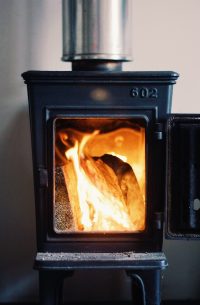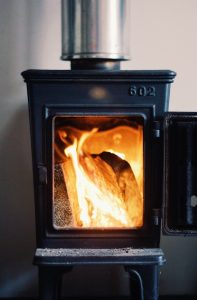Burning issue: clean air and woodfuel

The 2018 Clean Air Strategy is a key part of the government’s 25 Year Environment Plan and it tackles vehicle emissions, agricultural ammonia emissions and harmful domestic fuels. To quote from the press release, ‘Of particular concern is burning wood and coal to heat a home which contributes 38% of UK emissions of damaging particulate matter. Cleaner fuels and stoves produce less smoke, less soot and more heat. In future only the cleanest domestic fuels will be available for sale.’
Diesel vehicles and coal-burning are, rightly, first in the government’s sights, but those who believe that wood-burning is a sustainable source of energy may be left a tad confused by the smog of words around the subject.
Burning wet – or green – wood releases particulate matter into the atmosphere and this is especially problematic in urban areas. According to the government, wood- and coal-burning in homes contributes almost 40% of emissions of small particulate pollution, PM2.5, which is especially damaging to health. In rural areas emissions from domestic fires are obviously dispersed more freely.
Woodfuel or biomass remains a low carbon form of energy: each tree absorbs the same amount of carbon dioxide when growing as it releases when burned. If woodlands are managed in a sustainable manner, with coppicing and replanting, for example, new tree growth will continue to absorb carbon dioxide, off-setting that released by burning woodfuel. The recent popularity of wood-burning stoves is testament to the success of the campaign to pull people away from fossil fuel energy, both for reasons of cost and out of concern for the environment. Nevertheless, air pollution is a serious matter which we neglect at our peril.
 Owners of wood-burning stoves will no doubt be relieved to hear that there is no sign of a ban in the foreseeable future, but it would be foolish to rule out legislation entirely. The government has said it will legislate to ensure ‘only the cleanest domestic fuels’ will be on sale. This may include wood bearing the Woodsure ‘Ready to Burn’ logo, which indicates low moisture content. How this will impact on those who harvest their own logs for personal use is a moot point. Woodsure is a not-for-profit organisation that works to raise the quality of wood fuel in the industry.
Owners of wood-burning stoves will no doubt be relieved to hear that there is no sign of a ban in the foreseeable future, but it would be foolish to rule out legislation entirely. The government has said it will legislate to ensure ‘only the cleanest domestic fuels’ will be on sale. This may include wood bearing the Woodsure ‘Ready to Burn’ logo, which indicates low moisture content. How this will impact on those who harvest their own logs for personal use is a moot point. Woodsure is a not-for-profit organisation that works to raise the quality of wood fuel in the industry.
Living Woods readers will know that wood burns more efficiently once it has been seasoned and left to dry for at least 12 months and possibly longer, depending on the species. Moisture meters are easily and cheaply available to enable fire owners to check that their logs contain less than 20% moisture.
Modern wood-burners are generally cleaner and more efficient than older models and there are simple ways to ensure that we keep air pollution from our fires to a minimum:
• Get a moisture meter and burn logs with less than 20% water content.
• Wood-burners are more efficient and less polluting than open fires.
• Owners of wood-burning stoves should have them swept and cleaned every year.
• Check that stove controls are set to optimum level for burn efficiency.
• If you are installing a new stove, use a HETAS-licensed installer.
• Do not burn waste industrial wood which may be impregnated with paint or other chemicals.
For a more detailed discussion, read the advice from Woodsure, via their Ready to burn website.
